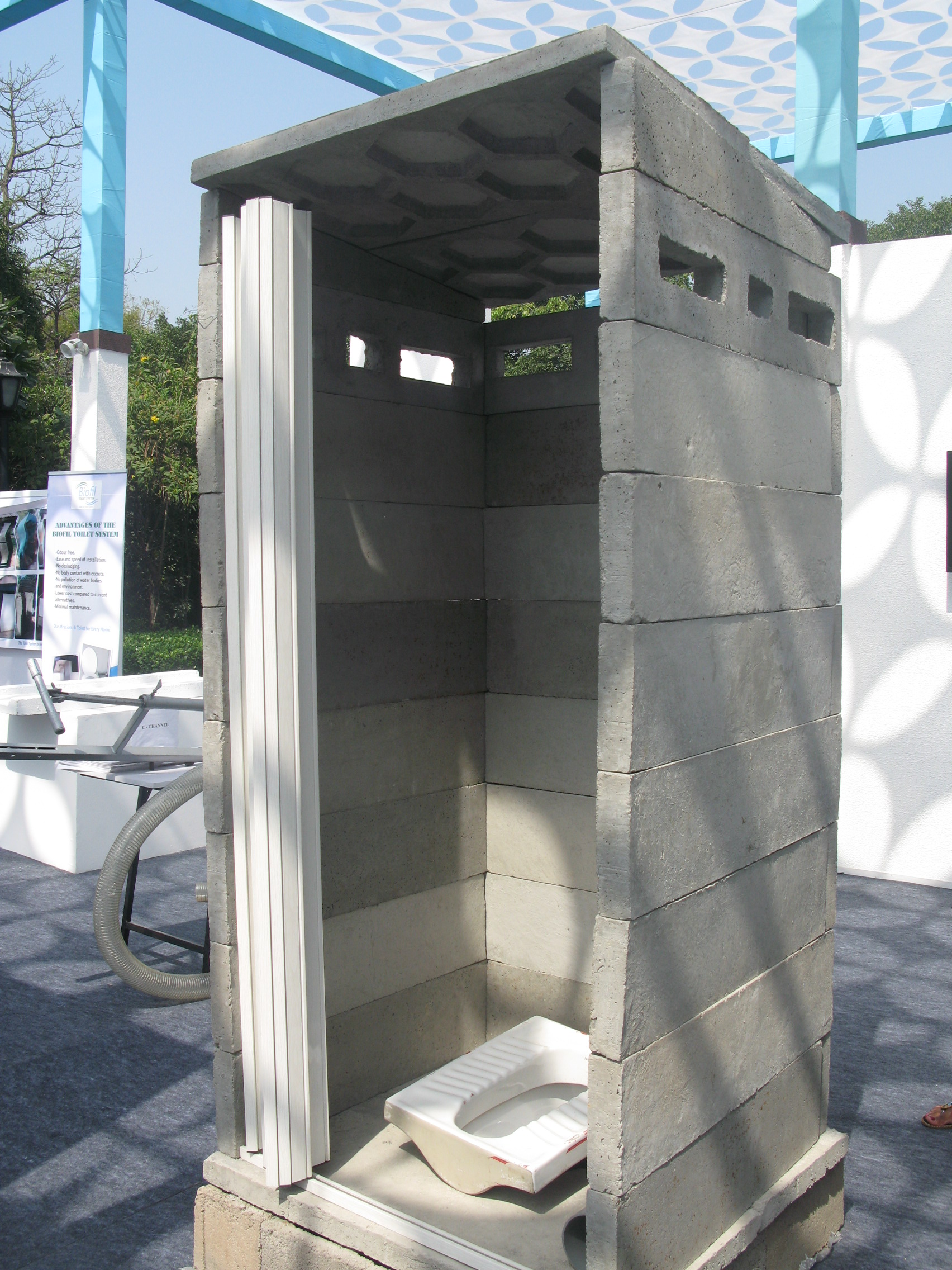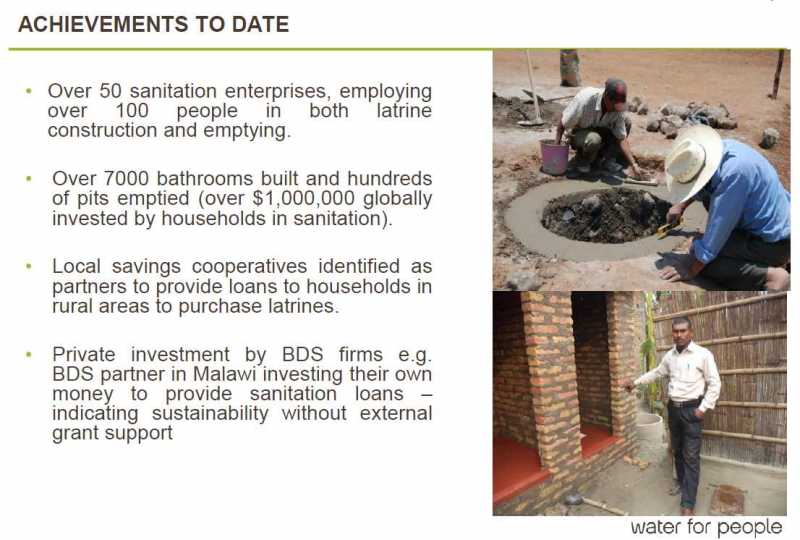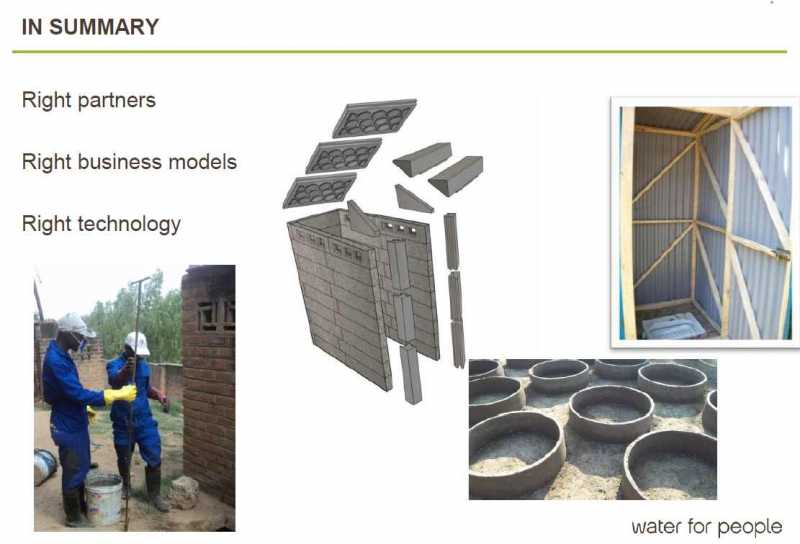- Markets, finance and governance
- Sanitation as a business and business models
- Catalyzing Sanitation Businesses - Sanitation as a Business, SAAB (Water for People, Uganda, Rwanda, Malawi, India, Bolivia, Peru, Ecuador)
Catalyzing Sanitation Businesses - Sanitation as a Business, SAAB (Water for People, Uganda, Rwanda, Malawi, India, Bolivia, Peru, Ecuador)
56.6k views
Re: Catalyzing Sanitation Businesses (Water for People, USA, Malawi, Uganda, India)
This message has an attachment file.
Please log in or register to see it.
Please Log in to join the conversation.
You need to login to replyRe: Catalyzing Sanitation Businesses - Sanitation as a Business, SAAB (Water for People, Uganda, Rwanda, Malawi, India, Bolivia, Peru, Ecuador)
The link below is a video interview from the fair giving some insight into the work that SAAB is doing, what makes our solutions unique and some of the challenges faced.
The second link below is a tour of the exhibits (the Durasan and Rammer) that SAAB displayed together with PATH and PSI
The technologies displayed addressed different levels of the sanitation value chain, and the experience interacting with different BMGF grantees will no doubt help SAAB to continue making technological improvements that offer better sanitation solutions to households and communities. For more information on the technologies that Sanihub is working on please visit www.sanihub.blogspot.com
++++++++++++
A photo from the exhibit (added by EvM):

Please Log in to join the conversation.
You need to login to replyWe would love to share our experiences. I have shared my contact information with you so please get in touch and I will be happy to point you to the right people in the respective countries.
Please Log in to join the conversation.
You need to login to reply- Ousmane66
-
Less
- Posts: 1
- Likes received: 0
Re: Learning experiences
Water For People has led several experiences of project related to « Sanitation As A Business » in several countries around the world. OXFAM starts this experience in Senegal and wish to learn of what has been accomplished in the context of poor countries like ours even if it can appear some socio –cultural differences.
Facilitate the « doing business « between private sector enterprises and poor households on one hand by helping them have access to appropriate sanitation technologies with low cost and on the other hand helping enterprises earn money is a challenge which requires learning from similar experiences. This is the reason why we want to visit experiences of WFP in different countries. Unfortunately we do not have contacts or addresses of people we can exchange with.
So could you please provide us with complete address or contact of persons who have implement the SAAB RWANDA, India, Malawi and Peru so that we can prepare and discuss with the possibility of learning visit in those countries.
Thank you so much and any other experiences you think good in this subject will be welcome and don’t hesitate to share them with us.
Regards
Please Log in to join the conversation.
You need to login to replyRe: Catalyzing Sanitation Businesses - Sanitation as a Business, SAAB (Water for People, Uganda, Rwanda, Malawi, India, Bolivia, Peru, Ecuador)
Thanks so much for your post and for transcribing the webinar content. This is a great way to keep the discussion going. Just a few clarifications on some of the issues that didn't come out quite clearly
You wrote:
The focus is on the private sector as the main driver; support to sanitation businesses; beefing up the businesses; not working with NGOs anymore; identify private sector business development support firms (still not clear to me: what is the exact definition of a BDS compared to just a normal private company?).
On this point, a BDS firm is a private sector company whose main focus is to provide business development support to sanitation businesses (such as latrine construction or pit emptying businesses) with the intention of raising the profile of these businesses and ultimately through this increasing provision of sanitation products and services through the market.
You asked:
We are currently supporting 50 sanitation enterprises. These are employing 100 people (thus 2 per firm – rather small companies – “2-man bands”?);
On this point, it should be noted that the composition of the businesses varies significantly. For example in Africa, there are 30 pit emptying businesses and these employ 3 people on average - two operators (or emptiers) and one driver/manager with their target areas being mostly urban sanitation slums and thus the small scale operation that requires business support in order to expand. In India, there are 14 entrepreneurs being supported to have sanitary shops or "Sani-Marts" that sell sanitation products like slabs, which again are not hugely staffed and only require on average two staff that are skilled at construction or development of these products
You asked:
Over 7000 bathrooms built (meaning 700 toilets built?); 300 latrines emptied (this makes me wonder: 300 latrines emptied in 3 years is not very much? And how do you know the number of latrines emptied, are you tracking each emptying service provider in 7 countries?)
Yes, this means 7000 toilets built across the countries of implementation. The latrine emptying business model (particularly using the gulper) was recently introduced and has been running over the last year rather than over the past three years. The identification of business model by the BDS firm, recruiting and training of entrepreneurs had to happen prior to entrepreneurs beginning actual implementation. Now that the business model has gained ground and more entrepreneurs are being recruited, this is bound to increase the number of latrines to be emptied. New technologies other than the gulper are also being explored.
You asked:
We have financially supported sanitation businesses to offer more affordable solutions (it wasn’t clear to me how exactly these sanitation businesses were supported? Are you effectively subsidising them so that they can lower the fees for the customers?)
The support to sanitation businesses is offered in terms of the business support provided for these businesses by the BDS firms that have been contracted. The BDS firms provide information on business models, operational and financial training, branding of businesses, marketing, identification of customers and development of business plans for business expansion. There are no subsidies to the businesses therefore but rather initial business support. Entrepreneurs invest their own money in starting up the businesses and therefore areas of support include helping to link businesses to financial institutions for loans to either start up or expand their businesses. Products and services are offered at market rates (no subsidies) but business models such as emptying with the gulper are designed to offer more affordable options (that are cheaper, say, compared to emptying using a tanker) and thus more affordable for households.
You asked:
Technology is a critical component in the market based approach (we need aspirational products) (wasn’t clear to me which aspirational products you are offering here?)
Regarding the aspirational products being offered, the SAAB project works with a technology arm (SaniHub) to design different latrine products for households. For example, latrines being distributed under the rural SAAB model are more aspirational for households offering better latrine product options. Links to some of the latrine technologies being developed can be found on sanitation.captivaafrica.com/sanihub
You asked:
Mark Illian asked; How are you reaching the poorest of the poor who have no farmland, no income, have disabilities – is there a floor or certain poverty level below which this approach doesn’t work?
Answer by Sherina:
"We are working with the government on this issue – provide some funding; supporting microfinance support centres." (I have to admit that I didn’t really understand Sherina’s answer here; it seemed to me that it sounded like for the poorest of the poor we will work with government subsidies again…)
To clarify further here, what we try to do (for example in the rural SAAB model), the government has some money available for local savings cooperatives and the aim is to target this towards funding low interest sanitation loans for poor households that will then be able to access latrine products and repay these over an extended time period such as 24months. This will make it more affordable to poorer households. While it must be recognized that the market-based approach will not work for "the poorest of the poor" that earn less than $1 households but the intention is to make sanitation more affordable for the poor. By its very nature, the market expects that people will pay for products without subsidies and so the focus of SAAB is to make these products more affordable (in supporting businesses) and also linking households to more affordable financing.
Please Log in to join the conversation.
You need to login to replyRe: Catalyzing Sanitation Businesses (Water for People, USA, Malawi, Uganda, India)
Thanks for your question. We are always looking for private sector partners to work with to implement our market-based sanitation approach. In fact, we currently accepting applications from BDS providers in the countries where we are implementing SAAB. Can you please send me an email on This email address is being protected from spambots. You need JavaScript enabled to view it. and I will send you the relevant application form.
Best wishes
Sherina.
This message has an attachment file.
Please log in or register to see it.
Please Log in to join the conversation.
You need to login to reply- saniwatersolutions
-
Less
- Posts: 2
- Likes received: 0
Re: Catalyzing Sanitation Businesses (Water for People, USA, Malawi, Uganda, India)
We are a company named SaniWater Solutions ( www.saniwatersolutions.com) based in Uttar Pradesh (UP) in India. Can we be a BDS for Water for People in Uttar Pradesh state of India ?
Regards
Jyoti Khare
Managing Partner
SaniWater Solutions
Please Log in to join the conversation.
You need to login to reply- Elisabeth
-
- User is blocked
- Freelance consultant since 2012
Less- Posts: 3372
- Karma: 54
- Likes received: 932
Re: Catalyzing Sanitation a a Business
As a service to those people who don't have access to Youtube videos I am posting here a summary of what Sherina presented and the questions that followed during the third webinar that SEI organised on 7 November (see Arno's post about it here: forum.susana.org/forum/categories/139-ge...g-now-available#6312).
Sherina Munyana was the second presenter in the webinar. She is based in Kampala, Uganda, where she works for Water for People.
The presentation of Sherina starts exactly here in the Youtube video:
Sanitation as a Businesses (SAAB)
by Sherina Munyana, Water for People, Uganda
Locations of research: Malawi, Uganda, Rwanda, India, Bolivia, Peru, Ecuador
The short presentation that she used for the webinar (note that she gave much more detail and additional information verbally than what is shown in the slides):
Please log in or register to see it.
Two slides from the presentation as a visual input:
This is a large multi-million dollar project (5.6 Million USD according to the public BMGF grant database, to be precise), and one cannot expect Sherina to explain it all in 5 minutes… While listening to the recording a second time, I realised that she could only hint at many of the things. But there are also quite a few reports on their websites for further reading. In any case, I think her short presentation gave a good general overview and made me inquisitive for more.
Their project website is up and running since the beginning of the year (or longer) and gives a good overview of the activities in the different countries:
sanitation.captivaafrica.com/country (this one seems to have a focus on Uganda, but also deals with the other 6 countries)
They also have this website: sanitation.tap.waterforpeople.org/ (although I am a bit confused by the layout of it and how it relates to the other website).
Some notes that I took while listening to her presentation:
- The project started 3 years ago in July 2010 (it is coming to an end middle of 2014).
- The countries where the project is active are: Uganda, Rwanda, Malawi, India, Peru, Bolivia, Ecuador; the examples given in this presentation were mainly from Uganda and Rwanda.
- Water for People is experimenting with market-based approaches to sanitation; no more subsidies and hand-outs to households or to NGOs (these hand-outs resulted in no ownership on the side of the households; households waiting for NGO to come back to fix the toilet if it needs fixing...)
- If I understood it right, the new approach is: rather than giving money to NGOs or to households, rather give money to private companies – which they call BDS firms which stands for “business development support firms”.
- The focus is on the private sector as the main driver; support to sanitation businesses; beefing up the businesses; not working with NGOs anymore; identify private sector business development support firms (still not clear to me: what is the exact definition of a BDS compared to just a normal private company?).
- In rural areas: business focus is on latrine construction (keep on constructing new latrines because there is enough space; in urban areas, such as Kampala, the focus is on latrine emptying (manual or mechanical).
- Initially: only one BDS firm per country (work with entrepreneurs and help them); but with just one BDS firm this created distortion in the market (e.g. maybe only tanker service for emptying – too expensive for some low-income customers); now have several BDS (at different levels; diversify types of sanitation businesses we are supporting).
- Achievements to date: working with 50 sanitation enterprises. These are employing 100 people (thus 2 per firm – rather small companies – “2-man bands”?); Over 7000 bathrooms built (meaning 700 toilets built?); 300 latrines emptied (this makes me wonder: 300 latrines emptied in 3 years is not very much? And how do you know the number of latrines emptied, are you tracking each emptying service provider in 7 countries?).
- We have financially supported sanitation businesses to offer more affordable solutions (it wasn’t clear to me how exactly these sanitation businesses were supported? Are you effectively subsidising them so that they can lower the fees for the customers?)
- Working with local savings cooperatives.
- The BDS firms are now investing their own money to provide sanitation loans to households; aim of the BDS in Malawi: support 5000 households per year in Malawi.
- Problem: profitable businesses (which we may want to support) might neglect poorest households, resulting in no service to these low income households.
- Emptying a pit latrine with a Gulper is popular with the entrepreneurs because Gulper has low upfront costs.
- Entrepreneurs are now formalizing their business, open bank accounts (but difficult to get loans). Get entrepreneurs to form an association, might be easier to get a loan as an association.
- Technology is a critical component in the market based approach (we need aspirational products) (wasn’t clear to me which aspirational products you are offering here?)
- Create sanitation hubs in each country – these should develop new and affordable products.
- Enabling environment: working with government – aiming for certification for entrepreneurs (e.g. pit emptiers) to operate legally and to offer quality services.
(1)
Nelson Ekane asked: what are major differences between the different regions you have worked in?
Answer by Sherina:
"In South America it is difficult to eliminate the mentality of subsidies: people do not expect to have to pay for sanitation but take it as a human right… Our solution: develop hybrid approach together with government, slowly introducing that there are less or no subsidies.. India compared to Africa: local savings cooperations and MFIs (micro finance institutions) who are willing to work with this model are easier to find in India than in Africa. In Africa we have tried to combine income generating loans with sanitation loans."
Comment by Christoph Platzer on this (his forum post on 11 November):
The different approaches by water for people mentioned by Sherina Munyana, and especially the different experiences seemed a very valuable observation to me, not only the difference between rural and urban sanitation, but as well the differences in the “culture” between Africa, Asia and South America. Although I think in South America there is room for business models as X runner is currently experiencing in Lima, and we had the experience as well, that the people were willing to pay for their toilets. A problem is, that they developed bad habits – lots of NGO or as well government activities sending in latrines without payment, therefore the people are not willing to spend on something they could get for free (Why should they?). Therefore we put in a strong rule for our activities with a different quality toilet... who does not pay part of the toilet structure, does not receive a toilet. It worked and still works out fine, but without any subsidy not possible. On the other hand, normal sanitation does not work without subsidy as well.
(2)
Mark Illian asked; How are you reaching the poorest of the poor who have no farmland, no income, have disabilities – is there a floor or certain poverty level below which this approach doesn’t work?
Answer by Sherina:
"We are working with the government on this issue – provide some funding; supporting microfinance support centres." (I have to admit that I didn’t really understand Sherina’s answer here; it seemed to me that it sounded like for the poorest of the poor we will work with government subsidies again…)
(3)
Dorothee Spuhler asked: How about treating the waste and trying to get a revenue from selling the product? Rather than just having revenue from user fees also have revenues from products of sludge treatment?
Answer by Sherina:
"Yes, this is part of our technology component. In Rwanda we are working with the BDS firm “Boundless” that is implementing a mini-DEWATS plant to treat sludge; there are however delays because we are working with the government on this; also, the costs for the treatment plants are higher" (I found this answer a bit vague, see also comment by Steve Sugden * below; which incentive does the BDS have to pay for treatment? Only works if the government enforces treatment – like it seems to happen in Rwanda? But this still doesn’t lead to any revenue from the product sale? Why use a DEWATS plant for sludge treatment, I only know it for wastewater treatment? So no treatment and reuse activities in the other 6 countries apart from Rwanda? It's easy to have profitable businesses if you are only concerning yourself with emptying... but what happens to the sludge exactly then? Where do they take it? Dumping it into nearest water course is the most common practice in general, how can you prevent this or is this outside of the scope of the SAAB project?)
(4)
Mark Illian asked: have you tried to couple your approach to CLTS?
Answer by Sherina:
“Not yet; we normally support work that is already existing in a certain district. We need to explore this idea further.”
(5)
Nelson Ekane asked: have you coupled your approach with the Community Health Clubs that are part of the local government system in Rwanda?
Answer by Sherina:
“Yes, the BDS “Boundless” in Rwanda that we support has worked with them; we are always looking for better ways of intervening in the community.”
Thank you to Sherina and all the participants in this webinar!
I hope you found this write-up of Sherina’s presentation and the discussion that followed useful.
Greetings,
Elisabeth
P.S.
*I found a Rwanda trip report from Steve Sugden from October 2013 on their website (sanitation.captivaafrica.com/content/rwa...-report-october-2013) which answered some of my questions regarding the issue of treatment of faecal sludge in Rwanda. Quite an honest description of the problems encountered – thanks, Steve (I hope you didn’t get into trouble for your frank words).
+++++++
++++++++++++The urban work has become stuck in the sludge. There are lots of stories involving long chains of people waiting for other people to make decisions, the unsuitability of particular sites, dreams of large treatment plants, the need for Water for People to enter agreements if cannot and should not enter, and the unresponsiveness of BORDA in supporting the technical design. The urban SAAB has fundamentally achieved nothing after two years and it is time to change the approach. Boundless submitted an investment proposal to manage the development of a treatment process, but given their past track record, this is not the route to go down.
The only positive from the last two years is the agreement from the government to develop a small treatment plant on a plot of land about 5 kms from the city center. The topography of the site makes it unsuitable for large tankers as heavy excavation would be needed to create a turning circle, but it is ideal for a piki-piki based transport system with a small treatment plant capable of accepting 2m³ to 3m³ a day. There is a large area of agricultural land close by on which crops could be irrigated by the effluent, or even the building of a constructed wetland.
Regards,
Elisabeth
Freelance consultant on environmental and climate projects
Attachments:
-
 Sherina2.jpg
(Filesize: 52KB)
Sherina2.jpg
(Filesize: 52KB)
-
 Sherina1.jpg
(Filesize: 36KB)
Sherina1.jpg
(Filesize: 36KB)
Please Log in to join the conversation.
You need to login to reply- Elisabeth
-
- User is blocked
- Freelance consultant since 2012
Less- Posts: 3372
- Karma: 54
- Likes received: 932
Re: Catalyzing Sanitation a a Business
Here is your chance to interact with Sherina (and two other grantees) live during the upcoming webinar hosted by SEI on this Thursday (7 Nov.) at 17:00 Sweden time. Some places are still left (with or without microphone rights, this depends), please see here for more information:
forum.susana.org/forum/categories/139-ge...nment-institute#6195
(If you miss the event live, you can view the recording on Youtube a few days later)
Freelance consultant on environmental and climate projects
Please Log in to join the conversation.
You need to login to replyPlease Log in to join the conversation.
You need to login to replywww.waterforpeople.org/media-center/orga...ws-october-2013.html
Please Log in to join the conversation.
You need to login to reply- Kiku
-

- Water and Sanitation Specialist
Less- Posts: 38
- Karma: 6
- Likes received: 18
Best,
Fredrick
Skype: tufre80
Please Log in to join the conversation.
You need to login to reply- Markets, finance and governance
- Sanitation as a business and business models
- Catalyzing Sanitation Businesses - Sanitation as a Business, SAAB (Water for People, Uganda, Rwanda, Malawi, India, Bolivia, Peru, Ecuador)







